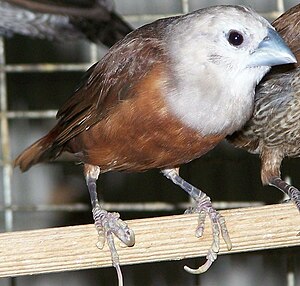Pale head nun
| Pale head nun | ||||||||||||
|---|---|---|---|---|---|---|---|---|---|---|---|---|

Pale-headed nun ( Lonchura pallida ) |
||||||||||||
| Systematics | ||||||||||||
|
||||||||||||
| Scientific name | ||||||||||||
| Lonchura pallida | ||||||||||||
| ( Wallace , 1864) |
The pale-headed nun ( Lonchura pallida ), also known as the yellow-bellied nun or white-headed reed finch , is a species of the finch family . There are two subspecies.
The kind belongs to the occasionally kept ornamental bird kinds.
description
The pale head nun reaches a body length of 11 centimeters. The forehead, the area around the eyes and the throat are whitish. The skull, neck and chest are pale gray-brown. The back, the wing covers and the wings are brown. The lower and upper tail-coverts as well as the tail feathers are red-brown. The sexes are similar, but the females and the young birds are slightly paler than the males. The male has a chant consisting of a series of ascending and descending tones that end with a trill or laugh.
distribution and habitat
The distribution area of the Blasskopfnonnen are the Lesser Sunda Islands and Sulawesi . Their habitat are bushy grasslands and rice fields. They also occur on the outskirts of towns. The maximum altitude up to which the Blasskopf nuns can be found is 1,000 meters. Little research has been done on the behavior of this species in the wild, but it probably resembles the whitehead nun .
On Flores , the breeding season falls at the beginning of the dry season, which usually falls in April and May. The courtship contains elements of a real Halmbalz and also includes beak fights. Pale headed nuns build their nests in the bushes or in the reeds. The clutch is incubated for 14 days. The nestling period lasts three weeks, the young birds are looked after by the parent birds for another two weeks.
attitude
The Blasskopfnonne is believed to have been introduced to Europe for the first time in 1879. Even after that, it was rarely offered. The first breeding took place in 1979. In the years that followed, it was reared several times, sometimes over several generations. To date, the species is only sporadically in trade.
supporting documents
literature
- Horst Bielfeld : Knowing and caring for 300 ornamental birds. Ulmer Verlag, Stuttgart 2009, ISBN 978-3-8001-5737-2 .
- Jürgen Nicolai (Ed.), Joachim Steinbacher (Ed.), Renate van den Elzen, Gerhard Hofmann: Prachtfinken - Australia, Oceania, Southeast Asia. Eugen Ulmer Verlag, Stuttgart 2001, ISBN 3-8001-3249-4 .
- Peter Clement , Alan Harris, John Davis: Finches and Sparrows - An Identification Guide. Christopher Helm, London 1993, ISBN 0-7136-8017-2 .
Web links
- Birdlife Factshett , accessed May 30, 2010
- Lonchura pallida inthe IUCN 2013 Red List of Threatened Species . Listed by: BirdLife International, 2012. Retrieved October 9, 2013.
Single receipts
- ↑ Nicolai et al., P. 242